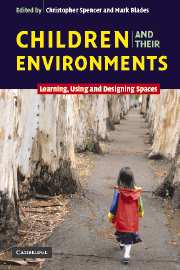Book contents
- Frontmatter
- Contents
- Notes on contributors
- An introduction
- Part I Children's understanding of places
- Part II Children's experience of places
- Part III Adolescents' worlds?
- Part IV Children and the design process
- 12 Children as agents in sustainable development: the ecology of competence
- 13 Children and city design: proactive process and the ‘renewal’ of childhood
- 14 A learning-based network approach to urban planning with young people
- 15 Young people's participation in constructing a socially just public sphere
- Index
- References
15 - Young people's participation in constructing a socially just public sphere
Published online by Cambridge University Press: 23 October 2009
- Frontmatter
- Contents
- Notes on contributors
- An introduction
- Part I Children's understanding of places
- Part II Children's experience of places
- Part III Adolescents' worlds?
- Part IV Children and the design process
- 12 Children as agents in sustainable development: the ecology of competence
- 13 Children and city design: proactive process and the ‘renewal’ of childhood
- 14 A learning-based network approach to urban planning with young people
- 15 Young people's participation in constructing a socially just public sphere
- Index
- References
Summary
‘Well the children because they were nice and … they were very idealistic, and they had some ideas that were out of the normal thinking. The adult community members … did provide some more practical information about the neighbourhood and that kind of thing. The practitioners were helpful in that they were, I don't know. Obviously the students were able to learn, the young kids were able to take a look at their neighbourhood and see how they might be able to improve it. And the adults would get a little taste of that idealism and maybe try to pursue something that they wouldn't have normally.’ (university student)
This student's reflections on how children's idealism can nudge adults out of sedimented ways of thinking provides the central theme of this chapter. Youth not only have a right to participate in social decision making, they benefit from such inclusion and can make valuable contributions to playful, transformative thinking. Youth participation yields collective and individual benefits, and is ‘part of the process and part of the answer for social inclusion’ (Hill et al., 2004). Yet, a powerful ontology of childhood delimits young people's opportunities for activism, framing them as adults-in-waiting (Wyness, 1999), rather than as social agents capable of bringing a uniquely valuable perspective to civic discourse (see also Francis and Lorenzo, this volume).
- Type
- Chapter
- Information
- Children and their EnvironmentsLearning, Using and Designing Spaces, pp. 256 - 276Publisher: Cambridge University PressPrint publication year: 2006
References
- 6
- Cited by



